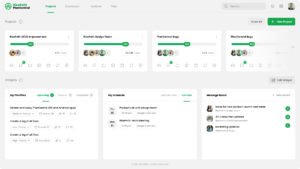Imagine wrangling a band of spirited toddlers in a sandbox. Toys, shovels, and buckets are scattered everywhere, there’s already (somehow inexplicably) sand everywhere, and heeding your call seems to be the least of their concerns. In the midst of this controlled chaos, someone is incessantly asking, “is it time yet?” while another is on the brink of tears.
That’s right; you’re metaphorically in the driver’s seat of this sandbox-meets-minivan scenario, seeming moments away from steering the entire operation into a ditch.
But you’re a pro at it, super-charged with your hard-earned expertise in construction management, of course.

You ace the delicate balance of maintaining transparent communication with clients and subcontractors, ticking off each step of the construction timeline precisely.
But somewhere, deep within, a nagging feeling persists. You know it could be smoother.
Also Read: What is Sales Planning? How to Create a Sales Plan
The effort seems disproportionately high, and the conviction is steadily rising that much of this chaos could easily be wrangled with the right plan and tools in your armory.
Understanding the Basics of a Construction Management Plan
A construction management plan (CMP) is a comprehensive document that outlines the strategy and procedures for the execution and completion of a construction project. It serves as a roadmap, guiding all parties involved in the project from start to finish.
The CMP encompasses various aspects including project scope, schedule, cost, quality, human resources, communications, risk management, procurement, and stakeholder management.
The project scope is a critical component of the CMP. It clearly defines what the project will accomplish, the deliverables, and the boundaries of the project. It helps to prevent scope creep, which can lead to delays and cost overruns.
The project schedule, on the other hand, outlines the timeline for the completion of each task and the project as a whole. It helps to ensure that the project is completed on time.
Cost management is another vital element of a CMP. It involves estimating the costs of the project, setting the budget, controlling costs, and managing changes to the budget. Quality management ensures that the project meets the required standards and specifications. It involves quality planning, quality assurance, and quality control.
Human resource management involves planning, recruiting, developing, and managing the project team. It ensures that the project has the necessary personnel with the right skills to complete the tasks. Communication management ensures that there is effective communication among the project team and other stakeholders. It involves planning, managing, and controlling all communication processes.
Risk management in a CMP involves identifying potential risks, analyzing their impact, and developing strategies to manage them. It helps to minimize the impact of risks on the project. Procurement management involves acquiring goods and services necessary for the project. It includes planning, conducting, controlling, and closing procurements.
Stakeholder management is the final key component of a CMP. It involves identifying all stakeholders, understanding their expectations and impact on the project, and managing their engagement. It ensures that stakeholders are satisfied and their needs are met.
In conclusion, a CMP is a vital tool for the successful completion of a construction project. It provides a clear plan and direction, ensuring that all aspects of the project are effectively managed.
Key Elements of a Construction Management Plan
A construction management plan is a comprehensive document that outlines how a construction project will be executed, monitored, and controlled. One of the key elements of such a plan is the project’s scope. This includes a detailed description of the work to be done, the project’s objectives, deliverables, and any specific requirements or constraints.
Another crucial element is the project schedule. This should include all the tasks and activities that need to be completed, their sequence, duration, and the resources required. It should also include key milestones and deadlines. The schedule should be realistic, achievable, and flexible enough to accommodate any unforeseen changes or delays.
Cost management is also a key element. This involves estimating the costs of all the tasks and activities, setting the budget, and controlling costs during the project. It’s important to include contingencies for unexpected costs or changes.
Quality management is another important element. This involves setting the quality standards for the project, and the methods and processes that will be used to ensure these standards are met. This could include quality control and quality assurance activities.
Risk management is a critical part of any construction management plan. This involves identifying potential risks, assessing their impact and likelihood, and planning how to mitigate them. This could involve contingency plans, risk response strategies, and regular risk reviews.
Communication is another key element. The plan should outline how information will be communicated to all stakeholders, including the project team, clients, and contractors. This could include regular meetings, reports, and updates.
Finally, the construction management plan should include a section on procurement management. This involves planning how resources and materials will be acquired for the project, including selecting suppliers, negotiating contracts, and managing relationships with suppliers.
Creating a Comprehensive Construction Management Plan Template
A comprehensive construction management plan template should begin with a project overview. This section should detail the project’s objectives, scope, and key stakeholders. It should also include a brief description of the project, including its location, duration, and estimated cost.
The next section should be dedicated to the project’s organization and staffing. This includes the roles and responsibilities of each team member, from the project manager to the subcontractors. It should also outline the reporting structure and communication plan, detailing how information will be shared and who will be responsible for what.
Also Read:The Best CRM Tools for Solar Companies
Following this, the template should include a detailed work breakdown structure. This is a hierarchical decomposition of the project into phases, deliverables, and work packages. It helps in understanding the cost, time, and resource requirements of each part of the project.
Risk management is another crucial part of a construction management plan template. This section should identify potential risks, their likelihood, and impact on the project. It should also outline strategies for mitigating these risks and contingency plans in case they occur.
The template should also have a section for quality management. This should detail the quality standards the project will adhere to, how these will be measured, and the procedures for dealing with any quality issues that arise.
Another important section is the procurement plan. This should outline the materials and services that will be procured, the procurement methods, and the criteria for selecting suppliers and contractors.
Finally, the template should include a section for project control and monitoring. This should detail how the project’s progress will be tracked, the key performance indicators, and the process for making changes to the project plan.
What’s included in a detailed construction management plan?
An all-encompassing construction management plan is geared towards the seamless execution of a construction project. It captures the material, human, and financial resources, as well as the necessary procedures to accomplish the project.
Typically, the following nine facets define a construction management plan:
- Scope: This consists of the project’s blueprints, main deliverables, and measures to keepscope creep in check. How do you plan to regulate the project scope?
- Schedule: A schedule includes the chief milestones or primary delivery dates. It outlines how the project’s timeline will be kept up-to-date.
- Budget: How do you foresee the budget allocation for the project? What are your strategies to maintain financial discipline and avoid going over budget?
- Resources: This section comprises who is needed to execute the project effectively (e.g., electricians, plumbers, etc.). Planning for adequate and well-timed resource allocation is crucial.
- Procurement: This involves all other necessities for the project, such as construction materials, supplies, subcontractors, machinery etc. Planning for sourcing at a favorable price, and ensuring availability on site when required, is vital.
- Quality: This includes the standards (building codes, etc.) that the project must abide by. How will you guarantee compliance?
- Risk: The risk section outlines the probable risks to the construction project. Formulating the tracking and management techniques for current and potential risks is necessary.
- Communications: This involves identifying stakeholders requiring project updates on progress, risks, and issues, along with the communication strategy.
- Change: This describes how changes to the project will be controlled and managed.
The beauty of a construction management plan (CMP) lies in its reuse potential. Once a CMP is drafted, several elements can be referenced, and tailored as required, for upcoming projects.
Though the project schedules might differ, the approach to manage them likely remains uniform upon defining a solid process.



Comments are closed, but trackbacks and pingbacks are open.